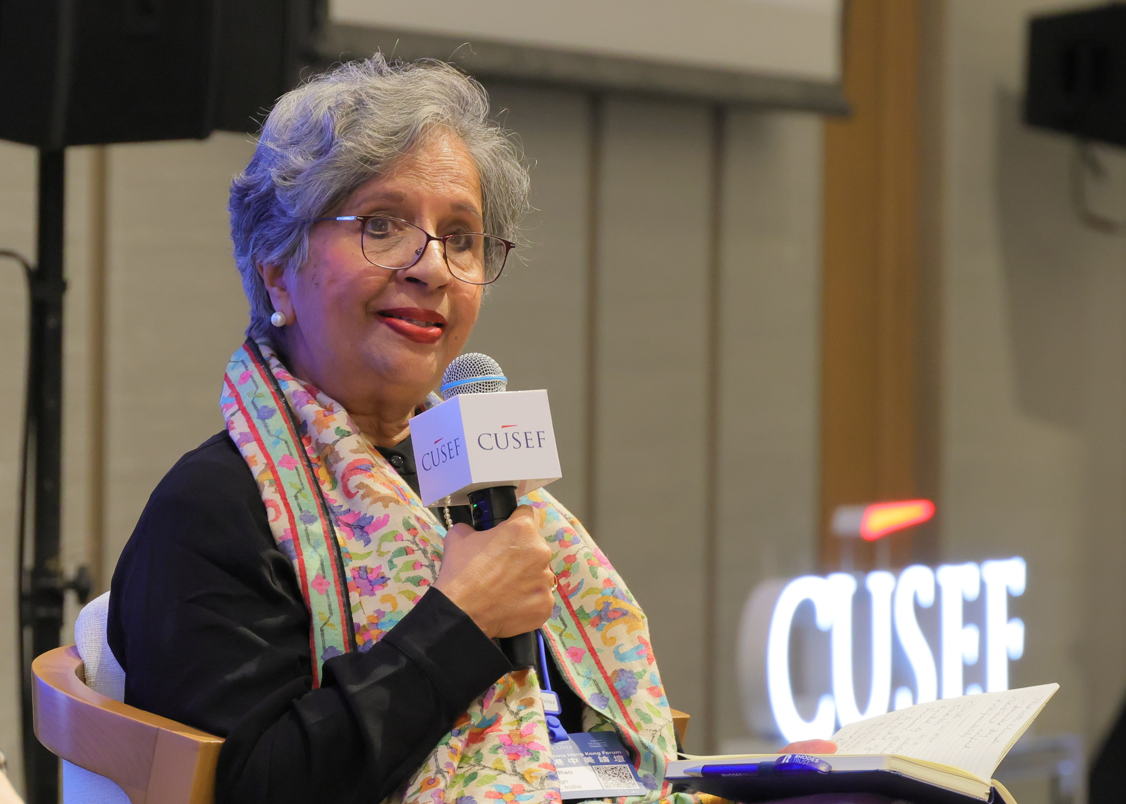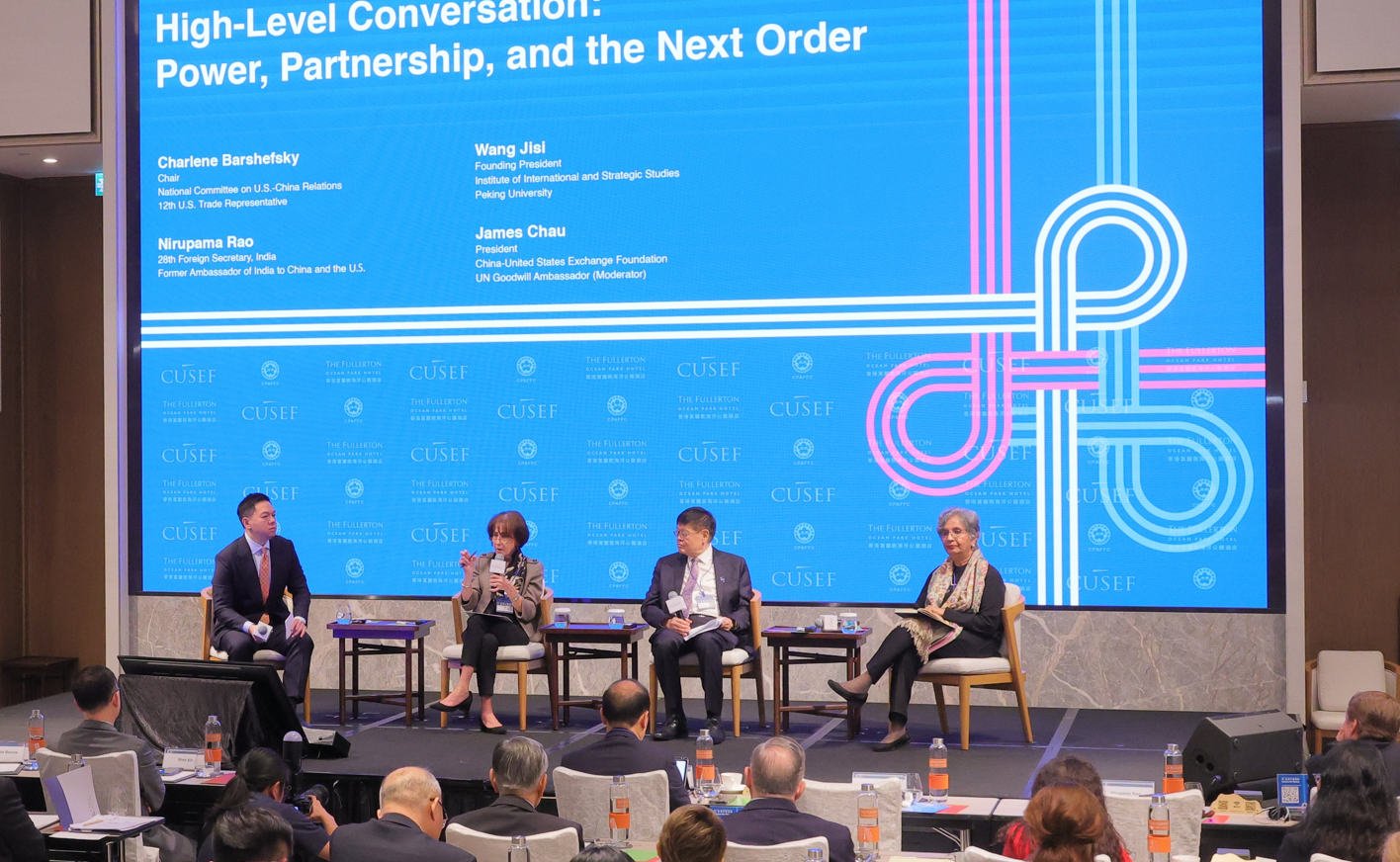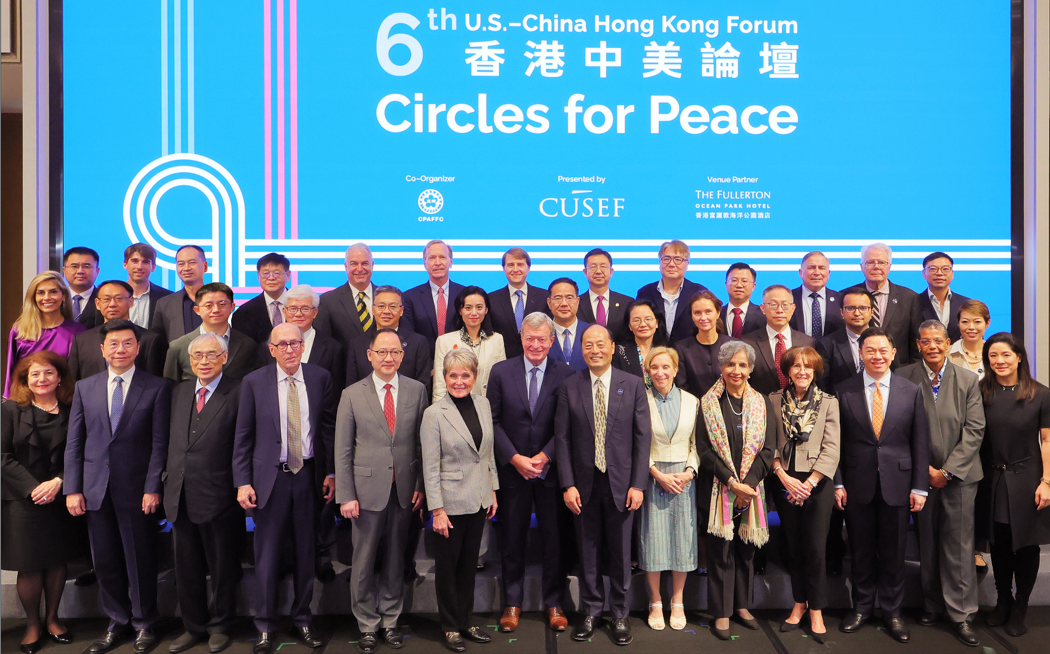In the tense relationship between the United States and China, Hong Kong emerges as a middle space — a vantage point from which to imagine a way forward. The city’s unique position offers a metaphorical middle ground for dialogue, emphasising the need for new frameworks to navigate today’s complex rivalries.
Nirupama Rao speaks at the high-level conversation "Power, Partnership, and the Next Order" at the 6th U.S.-China Hong Kong Forum on November 17, 2025. Watch the full video here.
On November 17 and 18, 2025, Hong Kong hosted the sixth meeting of the China-United States Exchange Foundation (CUSEF), titled ‘Circles for Peace’. Even though the U.S. and China remain locked in a tense, mistrustful relationship, they are also tied together more tightly than either side likes to admit. Here, Hong Kong, which has always lived between worlds, offers an uneasy middle space; a vantage point from which to imagine a way forward.
Complex rivalries
The discussions at the sixth U.S.-China Hong Kong Forum showed that trust had thinned, and that both the U.S. and China now operate as if expecting sudden shocks. Participants spoke with candour, and with a sense of fatigue. Old frameworks such as engagement, “guardrails”, and managed competition no longer felt adequate for today’s complex rivalry.
A persistent theme was the shrinking room for nuance. Strategic anxieties that once belonged to specialists have entered the public sphere, shaping domestic politics and narrowing the range of acceptable positions. It has also seeped into the human dimension of the relationship. American student numbers in China are far below pre-COVID-19 pandemic levels, and Chinese student enrolments in the U.S., once well above three lakh, have also declined. The deeper loss is familiarity – younger generations are encountering each other through narratives shaped by fear rather than through lived experience. Even though Presidents of both the nations anchor the relationship, personality-driven diplomacy is not enough in today’s world.
Further, technology, and Artificial Intelligence (AI) were the biggest topics of conversations. It was observed that AI now resembles an international public good – too consequential to be monopolised or monetised by any single country. A credible governance regime, participants said, must rest on equity, transparency and accountability. This, however, brought up broader concerns about the overlap between civilian innovation and defence applications, especially in parts of the private sector. There would be an eventual need for an international governance mechanism for AI, and possibly for space (“the galaxy”) as well. For if competition moves beyond the earth, who determines the rules?
The wider diplomatic climate also featured in the discussions, with the Taiwan question being a key issue. China argued that the discussion had become overwhelmingly militarised, and warned that American policy appeared to be drifting towards what Beijing views as a “one China, one Taiwan” (a position which advocates for the independence of Taiwan) posture. New mechanisms and a new vocabulary are needed to deal with the issue before it hardens into confrontation by default. One question discussed was whether the U.S. and China are prepared for another EP-3 incident (in 2001) – an accidental collision at sea or in the air that could escalate before political systems can respond. The region needs a crisis-prevention mechanism insulated from political swings.
Singapore’s former Defence Minister Ng Eng Hen offered the broadest frame. He described this period as a “dialectic moment”, where competing pressures reshape the global order but outcomes remain uncertain. The U.S., Europe and China will inevitably influence the emerging structure, he said, but the rest of the world should not allow the global commons to become collateral damage in major-power rivalry. The world does not need another hegemon, it needs powers capable of co-organising the future.
Hong Kong’s future depends on preserving its cosmopolitan function – its connectivity, and cultural hybridity that allow ideas to cross borders even when politics cannot
Hong Kong’s role
Throughout the forum, Hong Kong was in focus. While the city’s liminal geography stands out as a metaphor for the wider planetary condition, it is also becoming more China-centric, even as it tries to remain globally fluent. Its future depends on preserving its cosmopolitan function – its transparency, connectivity, and cultural hybridity that allow ideas to cross borders even when politics cannot. Hong Kong reminds one that the world’s middle spaces still matter, revealing pathways that pure geopolitics often miss.
People-to-people ties emerged as a gentle theme of hope in the meeting. Participants noted that official relations may be strained, but human contact remains the ballast that prevents larger relationships from capsizing.
Hong Kong, despite the pressures of recent years, continues to make such exchanges possible.
THE GIST
The discussions at the sixth U.S.-China Hong Kong Forum showed that trust had thinned, and that both the U.S. and China now operate as if expecting sudden shocks.
Hong Kong reminds one that the world’s middle spaces still matter, revealing pathways that pure geopolitics often miss.
The clearest insight from the forum was that the U.S.-China relationship will not be restored to its old shape. The political atmospherics will remain turbulent.
The 6th U.S.–China Hong Kong Forum opens on November 17 with calls for shared leadership, guardrails on AI, and a renewed commitment to peace. Visit U.S.-China Hong Kong Forum here.
Lessons for India
The conversations in the forum were a reminder that great-power relations may determine the climate of the world, but the weather is shaped by everyone else. India cannot control the forces buffeting the U.S.-China relationship, but can decide how to navigate them, and how to ensure that its own future is not written by default. Rigid binaries are unsustainable. India’s task is not to imitate U.S. rhetoric nor to accept Chinese narratives at face value. It is to build domestic strength – technological, economic and institutional – to navigate a fractured world without losing strategic autonomy. The forum’s emphasis on youth, cultural ties and the social contract around technology offered reminders that relationships are not made or unmade by summits alone. They are shaped by steady habits of engagement.
The shape of a new order
The clearest insight from the forum was that the U.S.-China relationship will not be restored to its old shape. The political atmospherics will remain turbulent. But the alternative to managed rivalry is not victory; it is a world of cascading risks – climate stress, pandemics, fragile supply chains, and polarised societies.
One participant put it simply that this was “A story we have to write together”. The phrasing carries weight. It shifts the conversation from competition to stewardship, from ideology to survival. The next order, if it emerges at all, will depend less on grand bargains and more on practical cooperation on energy, health, finance, and AI governance.
As the forum ended and one stepped out into the evening, the view from the conference venue stayed, of a South China Sea almost motionless, and meditative, in quiet contrast to the anxieties that shape the region – a reminder of how places, like people, survive by embracing complexity and allowing themselves room to rethink. The U.S. and China will continue to compete, sometimes fiercely. The future needs steady hands to shape it.
India has its own long arc with China, marked by caution and conviction. Yet, in this moment of global uncertainty, the challenge for all three countries is the same: to choose responsibility over reflex, and to widen the narrow spaces where dialogue is still possible.
Hong Kong, in its imperfect, resilient way, showed that those spaces still exist.
This article was first published by The Hindu.



